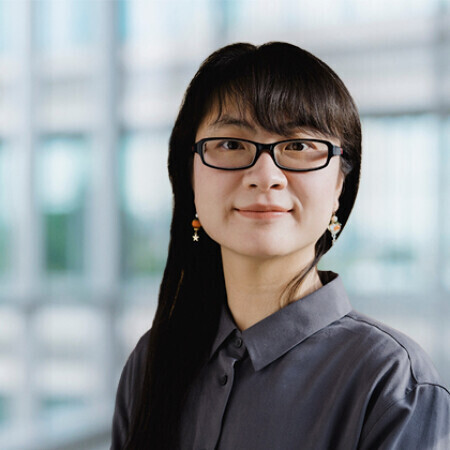Ph.D. - Cognitive Neuroscience
Dartmouth College - 2018

Jiahui Guo
Assistant Professor - Department of Psychology
Research interests: Cognitive and computational neuroscience of high-level perception and cognition (e.g., face recognition, social perception) in typical and neuropsychological populations; Naturalistic stimuli; Neuroimaging methods; Artificial intelligence; Deep neural networks
972-883-4444
GR4.802C
Cognitive & Computational Neuroscience (CoCo-Neuro) Lab
Google Scholar
Curriculum Vitae
Currently accepting graduate students
Not currently accepting undergraduate students
Professional Preparation
B.S. - Psychology
Beijing Normal University - 2013
Beijing Normal University - 2013
Research Areas
Understanding the Neural Basis of High-Level Cognitive Functions
Humans excel at performing complex cognitive tasks (e.g., face recognition, social perception), and uncovering the neural underpinnings of these high-level functions is key to understanding the functional principles of the human brain, the nature of human intelligence, and improving real-world applications. In this research domain, I leverage neuroimaging data and computational algorithms (e.g., hyperalignment) to achieve precise mapping of individualized functional brain topographies using naturalistic stimuli such as feature movies (Jiahui et al., NeuroImage, 2020; eLife, 2023). Moreover, I utilize computational modeling techniques, such as machine learning, to explore the functions and organizational patterns of these brain regions. Additionally, I incorporate human behavioral and psychological measurements to examine how these neural foundations contribute to the variety of human behavioral outcomes.Representations of Real-World Stimuli
Dynamic features (e.g., expressions) play an important role in real-world face and social representations. For instance, real-world faces convey information through both static (e.g., identity) and dynamic (e.g., expression, head orientation) features, and neural responses to dynamic face perception differ from those to static image-based perception. Previous results indicate that human biological representations of dynamic, naturalistic faces are different from those of state-of-the-art artificial neural networks (ANNs) (Jiahui et al., PNAS, 2023). Besides dynamic features, social cues (e.g., trustworthiness, dominance, attractiveness) and other cognitive processes such as memory and attention, affect real-world representations interactively. In this line of research, I combine ANNs, neuroimaging, behavioral experiments, and computational modeling to uncover the neural and behavioral representations of real-world scenarios with naturalistic stimuli and contribute to the development of future artificial intelligence (AI).Modeling Neuropsychological and Clinical Populations
Research involving neuropsychological and clinical populations provides critical insights into unique brain dysfunctions, enabling us to draw causal inferences about underlying mechanisms. For instance, studies on individuals with prosopagnosia, who struggle with face recognition, have advanced our understanding of the human face processing system (Jiahui et al., PNAS, 2018; Jiahui et al., Neuropsychologia, 2017). By implementing computational modeling algorithms and integrating neuroimaging and neuropsychological assessments, this line of research aims to uncover the specific functional-anatomical correspondences and investigate how neural activities shape behaviors. Furthermore, these studies are crucial for identifying key differences between neurotypical individuals and those from neuropsychological or clinical populations, and pinpointing neural and behavioral features that are clinically meaningful. Recognizing people with those features will help with early diagnosis and individualized treatment plans.Shared Neural Representations Across A Broad Spectrum of Ages and Species
A comprehensive investigation of neural representations in real-world situations across ages and species will contribute to the understanding of brain development and its origin and will also provide a basis for the development of high-quality educational and health programs in the future. In this research area, the primary focus is on identifying key features that could capture the anatomical and functional changes in the brain during development and understand the way they are characterized in real-life situations between human and macaque brains. By deriving and optimizing computational models, using neuroimaging and psychometric testing techniques, and combining ANNs, I will examine how human brain functions and organizations change across ages and species to advance our knowledge of brain homology and qualitative brain development across ages and since the split between macaques and humans.Publications
Feilong, M., Jiahui, G., Gobbini, M.I., Haxby, J.V. (2024) A cortical surface template for human neuroscience. Nature Methods - Journal Article
Jiahui, G., Feilong, M., Nastase, S.A., Haxby, J.V., Gobbini, M.I. (2023). Cross-movie prediction of individualized functional topography. eLife - Journal Article
Jiahui, G.†, Feilong, M.†, Visconti di Oleggio Castello, M., Nastase, S.A., Haxby, J.V., Gobbini, M.I. (2023). Modeling naturalistic face processing in humans with deep convolutional neural networks. Proceedings of the National Academy of Sciences (PNAS) - Journal Article
Lee, C., Han, J., Feilong, M., Jiahui, G., Haxby, J.V., Baldassano C. (2023). Hyper-HMM: aligning human brains and semantic features in a common latent event space. Thirty-seventh Conference on Neural Information Processing Systems (NeurIPS) - Conference Paper
Feilong, M., Nastase, S.A., Jiahui, G., Halchenko, Y.O., Gobbini, M.I., Haxby, J.V. (2023). The Individualized Neural Tuning Model: Precise and generalizable cartography of functional architecture in individual brains. ImagingNeuroscience - Journal Article
Parker, B.J., Voorhies, W.I., Jiahui, G., Miller, J.A., Willbrand E., Hallock T., Furl, N., Garrido, L., Duchaine, B., & Weiner, K.S. (2023). Hominoid-specific sulcal variability is related to face perception ability. Brain structure & function - Journal Article
Jiahui, G., Yang, H., & Duchaine, B. (2020). Attentional modulation differentially affects ventral and dorsal face areas in both normal participants and developmental prosopagnosics. Cognitive Neuropsychology - Journal Article
Jiahui, G., Feilong, M., Visconti di Oleggio Castello, M., Guntupalli, J.S., Chauhan, V., Haxby, J.V., and Gobbini, M.I. (2020). Predicting individual face-selective topography using naturalistic stimuli. NeuroImage - Journal Article
Awards
Leading Women in Neuro-AI UNIQUE-IVADO - Montreal AI and Neuroscience (MAIN) [2021]
Dartmouth Marie Center Excellence in Research - Dartmouth College [2019]
Fellowship for Graduate Study and Research - Dartmouth College [2013]
Appointments
Assistant Professor
University of Texas at Dallas [2024–Present]
University of Texas at Dallas [2024–Present]
Postdoctoral Scholar
Dartmouth College [2019–2023]
Dartmouth College [2019–2023]